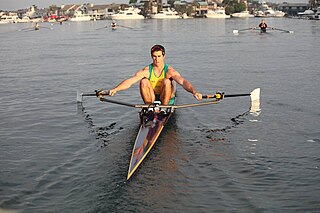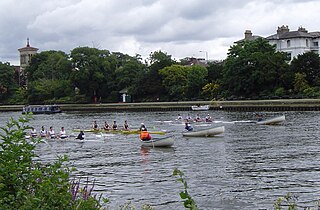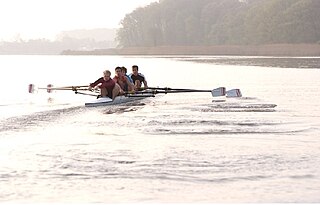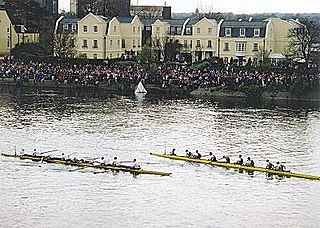
Rowing, often called crew in the United States, is the sport of racing boats using oars. It differs from paddling sports in that rowing oars are attached to the boat using rowlocks, while paddles are not connected to the boat. Rowing is divided into two disciplines: sculling and sweep rowing. In sculling, each rower holds two oars, one in each hand, while in sweep rowing each rower holds one oar with both hands. There are several boat classes in which athletes may compete, ranging from single sculls, occupied by one person, to shells with eight rowers and a coxswain, called eights. There are a wide variety of course types and formats of racing, but most elite and championship level racing is conducted on calm water courses 2 kilometres (1.2 mi) long with several lanes marked using buoys.

Sculling is the use of oars to propel a boat by moving them through the water on both sides of the craft, or moving one oar over the stern. A long, narrow boat with sliding seats, rigged with two oars per rower may be referred to as a scull, its oars may be referred to as sculls and a person rowing it referred to as sculler.

A head race is a time-trial competition in the sport of rowing. Head races are typically held in the fall, winter and spring seasons. These events draw many athletes as well as observers. In this form of racing, rowers race against the clock where the crew or rower completing the course in the shortest time in their age, ability and boat-class category is deemed the winner.

In watercraft, a racing shell is an extremely narrow, and often comparatively long, rowing boat specifically designed for racing or exercise. It is equipped with long oars, outriggers to hold the oarlocks away from the boat, and sliding seats. The boat's long length and semicircular cross-section reduce drag to a minimum. This makes the boat both fast and unstable. It must be balanced by the rowers to avoid tipping. Being able to balance – or "set" – the boat while putting maximum effort into the oars is therefore an essential skill of sport rowing.
In competitive rowing, the following specialized terms are important in the corresponding aspects of the sport:

Hampton School Boat Club (HSBC) is the rowing club of Hampton School. Each year the club produces 1st VIIIs that compete at Championship level in the United Kingdom. The club hosts two Head race events each year.

In rowing, oars are used to propel the boat. Oars differ from paddles in that they use a fixed or sliding fulcrum, an oarlock or rowlock attached to the side of the boat, to transfer power from the handle to the blade, rather than using the athlete's shoulders or hands as the pivot-point as in canoeing and kayaking.

In a rowing crew, the coxswain is a crewmember who does not row but directs the boat. The coxswain sits facing the bow, unlike the rowers, and is responsible for steering the boat and coordinating the power and rhythm of the rowers. The coxswain's role while on the water is similar to that of an assistant coach or team captain, and they are sometimes also called upon to implement the training regimen or race plan.

A coxless pair, abbreviated as a 2- and also known as a straight pair, is a racing shell used in the sport of competitive rowing. It is designed for two rowers, who propel the boat with sweep oars.
In the sport of rowing, each rower is numbered by boat position in ascending order from the bow to the stern. The person who is seated on the first seat is always the 'bow', the closest to the stern is commonly referred to as the 'stroke'. There are some exceptions to this: Rowers in continental Europe number from stern up to bow. Certain crew members have other informal titles and roles. Stroke seat in most cases is responsible for keeping pace for the boat, while the coxswain is responsible for the steering of the boat.

A single scull, abbreviated as a 1x, is a racing shell designed for a single person who propels the boat with two oars, one in each hand.

A double scull, also abbreviated as a 2x, is a rowing boat used in the sport of competitive rowing. It is designed for two persons who propel the boat by sculling with two oars each, one in each hand.

A quadruple sculling boat, often simply called a quad and abbreviated as a 4x, is a racing shell used in the sport of competitive rowing. It is designed for four people who propel the boat by sculling with two oars, or "sculls", one in each hand.

A coxed four, abbreviated as a 4+, is a racing shell used in the sport of competitive rowing. It is designed for four persons who propel the boat with sweep oars and is steered by a coxswain.

A coxless four, abbreviated as a 4- and also called a straight four, is a racing shell used in the sport of competitive rowing. It is designed for four persons who propel the boat with sweep oars, without a coxswain.

A coxed pair, abbreviated as a 2+, is a racing shell used in the sport of competitive rowing. It is designed for two persons who propel the boat with sweep oars and is steered by a coxswain (cox).

An eight, abbreviated as an 8+, is a racing shell used in competitive rowing (crew). It is designed for eight rowers, who propel the boat with sweep oars, and is steered by a coxswain, or "cox".

Sweep rowing is one of two disciplines of the sport of rowing. In sweep rowing each rower has one oar, usually held with both hands. As each rower has only one oar, the rowers have to be paired so that there are equal numbers of oars on each side of the boat. In the United Kingdom, rowing generally refers to sweep rowing only. The term pulling was also used historically. In the other rowing discipline, sculling, each rower holds two oars, one in each hand.

Human-powered watercraft are watercraft propelled only by human power, instead of being propelled by wind power or an engine.

Stern sculling is the use of a single oar over the stern of a boat to propel it with side-to-side motions that create forward lift in the water. The strict terminology of propulsion by oar is complex and contradictory, and varies by context. Stern sculling may also simply be referred to as "sculling", most commonly so in a maritime situation. In fresh water, and particularly in sport rowing, sculling is use of two oars on either side of the boat by each person, in contrast to sweep rowing, whereby each boat crew member employs a single oar, complemented by another crew member working on the opposite side with their oar.



















